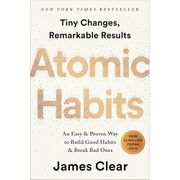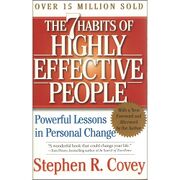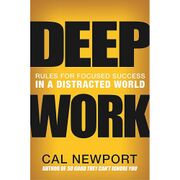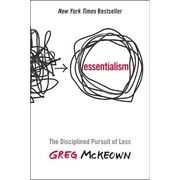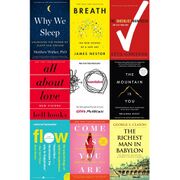The Power of Habit
🍎 Healthy brain food
"Some habits have the power to start a chain reaction, changing other habits as they move through an organization."
— Charles Duhigg, The Power of Habit (2012)
Introduction
| The Power of Habit | |
|---|---|
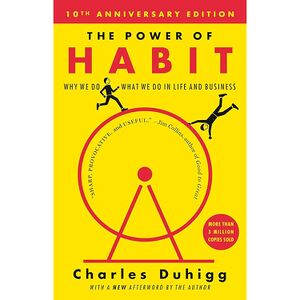 | |
| Full title | The Power of Habit: Why We Do What We Do in Life and Business |
| Author | Charles Duhigg |
| Language | English |
| Subject | Habit formation; Behavior change; Personal development |
| Genre | Nonfiction; Self-help |
| Publisher | Random House |
Publication date | 28 February 2012 |
| Publication place | United States |
| Media type | Print (hardcover, paperback); e-book; audiobook |
| Pages | 371 |
| ISBN | 978-1-4000-6928-6 |
| Goodreads rating | 4.1/5 (as of 6 November 2025) |
| Website | penguinrandomhouse.com |
📘 The Power of Habit (2012) is a nonfiction book by New York Times journalist Charles Duhigg that explains why habits exist and how they can be changed.[1][2] It popularizes a simple “habit loop”—cue–routine–reward—and argues that swapping routines while keeping cues and rewards can reshape behavior.[3] The book is organized into three parts—individuals, organizations, and societies.[4] Its narrative journalism blends case studies (for example, Alcoa, Starbucks, and Target) with neuroscience and social science reporting to make research actionable for general readers.[5] The book became a New York Times bestseller, sold more than three million copies, and was named a Wall Street Journal and Financial Times Best Book of the Year (publisher claim).[1] By August 2012 it had spent nineteen weeks on the New York Times hardcover nonfiction list, reflecting sustained popular interest.[6]
Chapter summary
This outline follows the Random House hardcover first edition (2012; ISBN 978-1-4000-6928-6).[1][7]
I – The Habits of Individuals
🔁 1 – The Habit Loop: How Habits Work. In 1993, Eugene Pauly (“E.P.”) arrived at the University of California, San Diego to see memory researcher Larry Squire after viral encephalitis had destroyed parts of his medial temporal lobe yet left his basal ganglia intact. Squire tested him with sixteen small objects glued to cards in eight fixed pairs; one card in each pair hid a “correct” sticker. Though E.P. could not recall the sessions, after twenty-eight days he picked the “correct” items about 85 percent of the time, and by thirty-six days roughly 95 percent, showing learning without recall. The same pattern explained why he could walk around his block and find the jar of nuts in his kitchen yet became lost when street repairs or fallen branches altered familiar cues. MIT researchers saw a parallel in rats running a T-maze for chocolate: as the task became automatic, brain activity spiked at the start and finish while the basal ganglia “chunked” the routine in between. These findings reveal a simple loop—cue, routine, reward—governing how the brain conserves effort by handing repeated tasks to habit circuitry. The mechanism is efficient but brittle: keep the cues stable and the routine fires; disturb them and behavior can crumble, for good or ill. The book argues that without habit loops, everyday life would overwhelm the brain.[2]
🧲 2 – The Craving Brain: How to Create New Habits. Early in the twentieth century, advertising pioneer Claude C. Hopkins made Pepsodent a hit by telling people to feel the “tooth film” on their teeth and tying brushing to a minty, tingling finish. According to figures reported in the book, fewer than 10 percent of Americans kept toothpaste in their medicine cabinets before his campaign; within a decade, more than 65 percent did, as the sensory payoff turned into something people looked forward to each day. In laboratories, Wolfram Schultz tracked a monkey named Julio as a juice reward moved from surprise to expectation: dopamine firing migrated from the reward to the cue, marking the moment a craving took hold. Procter & Gamble later stumbled with scentless Febreze because few consumers noticed odorless results, then revived sales by positioning a fragranced spritz as the satisfying end of a cleaning ritual. Together, these cases show that cues and rewards don’t stick until the brain learns to anticipate the reward and “wants” it. Craving is presented as the propulsion system inside the habit loop, translating a noticed cue into an eager routine that persists.[2]
✨ 3 – The Golden Rule of Habit Change: Why Transformation Occurs. On an autumn afternoon in San Diego, with 8:19 left on the clock and the Chargers backed up on their own twenty-yard line, Tampa Bay Buccaneers coach Tony Dungy bet the game on a simple philosophy: keep the same cues and rewards while teaching a new automatic routine. Hired in 1996, he drilled players to react faster by stripping decisions to rehearsed responses, turning the team from perennial also-ran to a contender. The same rule, researchers at Yale, the University of Chicago, and the University of New Mexico observed, helps Alcoholics Anonymous work by preserving the familiar cues (loneliness, stress, a bar on the corner) and rewards (relief, companionship) while replacing drinking with meetings, sponsors, and calls. In 2007, neurologists in Magdeburg implanted stimulators in the basal ganglia of five severe alcoholics; when the current was on, cue-triggered cravings quieted, and when off, urges surged back—evidence that old loops persist unless a new routine takes their place. The chapter argues that bad habits aren’t extinguished; they are replaced by new routines while cues and rewards remain constant.[2]
II – The Habits of Successful Organizations
🗝️ 4 – Keystone Habits, or The Ballad of Paul O’Neill: Which Habits Matter Most. At his first investor presentation after taking the helm at Alcoa, Paul O’Neill stunned Wall Street by pointing to the ballroom’s fire exits and declaring worker safety the company’s lodestar instead of profits. Within a year, profits hit a record high; by the time he retired in 2000, annual net income was five times what it had been and market capitalization had risen by $27 billion, even as Alcoa became one of the safest firms in the world. Before O’Neill arrived, nearly every plant recorded at least one accident a week; after his plan took hold, some facilities went years without a lost workday, and the injury rate fell to one-twentieth of the U.S. average. He encoded a habit loop into management: when an employee was injured (cue), the unit president had to call him within twenty-four hours with a prevention plan (routine), and only leaders who embraced the system were promoted (reward). The chapter emphasizes “small wins” and keystone habits as levers that cascade improvements across an organization.[2]
☕ 5 – Starbucks and the Habit of Success: When Willpower Becomes Automatic. The story follows Travis Leach, who grew up in Lodi, California, saw his father overdose at nine, dropped out of high school at sixteen, and struggled to keep jobs until Starbucks hired him and taught skills he had never learned at home. Managers handed him a workbook with blank pages—“When a customer is unhappy, my plan is to …”—and drilled the LATTE routine: Listen, Acknowledge, Take action, Thank, and Explain. The company layered more scripts for pressure points—What-What-Why for giving criticism and Connect-Discover-Respond for taking orders during rushes—and role-played until responses were automatic. Duhigg pairs Travis’s training with research on “implementation intentions,” such as Scottish surgery patients who wrote down when and how they would resume walking; those pre-plans made sticking to painful rehab far more likely. Starbucks also boosts a sense of control—rearranging bar layouts, inviting employees to decide greetings—which research links to stronger self-discipline on the job. The book frames willpower as a practiced routine cued by predictable stressors, turning self-control into an automatic response that scales under pressure.[2]
🚨 6 – The Power of a Crisis: How Leaders Create Habits Through Accident and Design. An elderly man—eighty-six years old—arrived at Rhode Island Hospital with a subdural hematoma; amid corrosive routines and silenced nurses, the surgical team operated on the wrong side of his skull, triggering a storm of headlines and investigations. Inside the hospital, staff had evolved defensive “truces,” including color-coded whiteboards to warn about volatile physicians, but those improvised habits failed when stakes were highest. Under new chief quality officer Dr. Mary Reich Cooper, leaders reframed the scandal as opportunity: they shut elective surgery for a day, mandated checklists, installed OR cameras to confirm time-outs, and created an anonymous reporting system. Since fully implementing the reforms in 2009, the hospital reported no wrong-site errors and later earned a Beacon Award and recognition from the American College of Surgeons. The chapter argues that effective leaders use crises to disrupt toxic truces and install better organizational habits before old patterns re-solidify.[2]
🎯 7 – How Target Knows What You Want Before You Do: When Companies Predict (and Manipulate) Habits. Andrew Pole, a statistician who joined Target in 2002, was asked by marketers whether data could reveal which shoppers were pregnant. Inside the chain’s data warehouse, each customer carried a “Guest ID” that linked store and online purchases to demographics and, when available, baby-registry due dates. Mining those records, Pole flagged roughly twenty-five products that reliably signaled pregnancy timing: unscented lotion spikes in the second trimester; later, bundled purchases of scent-free soap, cotton balls, hand sanitizers, and piles of washcloths, often after vitamins like calcium, magnesium, and zinc. Target’s aim was to reach new parents before competitors, but blunt diaper mailers felt invasive, so the team tested mailers that mingled baby coupons with familiar, unrelated items and timed them to trimester windows. The same principle made OutKast’s “Hey Ya!” a hit: programmers at Philadelphia’s WIOQ “sandwiched” the unfamiliar track between sticky favorites, cutting tune-outs from 26.6% to 13.7% to 5.7% as repetition bred comfort. The book argues that companies change behavior most easily when new routines piggyback on cues and rewards people already expect.[2]
III – The Habits of Societies
🚌 8 – Saddleback Church and the Montgomery Bus Boycott: How Movements Happen. Rosa Parks’s arrest in Montgomery activated the city’s dense web of clubs, churches, and civic groups: E. D. Nixon arranged bail with attorney Clifford Durr, and Jo Ann Robinson rallied schoolteachers late at night to print and spread flyers urging a one-day boycott. Because Parks was respected across overlapping circles, friends organized carpools and mass meetings before apathy could set in. The protest scaled through “weak ties,” the kind of acquaintances Mark Granovetter documented in his study of 282 job seekers—links that carry social pressure across networks and make opting out costly. When ninety people were indicted months later, almost all presented themselves at the courthouse, enacting a public script of resolve. Martin Luther King Jr. reframed the struggle in religious terms and embedded new routines—nightly meetings, disciplined nonviolence, self-directed roles—that turned followers into leaders. On 5 June 1956 a federal panel struck down bus segregation; the Supreme Court affirmed on 17 December, and the next morning at 5:55 a.m. King, Nixon, and Ralph Abernathy rode at the front of an integrated bus. The chapter frames movements as collective habit formation: friendship networks ignite action, weak-tie obligations spread it, and leader-supplied routines sustain it.[2]
🧠 9 – The Neurology of Free Will: Are We Responsible for Our Habits?. Angie Bachmann, a suburban mother facing long, empty days after her youngest started school, tried a nearby riverboat casino, lost $40 at a blackjack table, and felt a relief that soon drew her back. By 2001 she was going daily; in one twelve-hour stretch she lost $250,000. Harrah’s Entertainment, renowned for predictive marketing, tracked her play and in March 2006 invited her with a line of credit; that night she signed six markers totaling $125,000, chased a brief hot streak, and ended deeper in debt before the company later sued, seeking repayment plus $375,000 in penalties. In parallel, a British tourist named Brian Thomas strangled his wife during a sleep terror; after a sleep-lab evaluation showed automatism, a judge invited a not-guilty verdict. Neuroscientist Reza Habib’s 2010 MRI study of twenty-two people—half diagnosed as pathological gamblers—showed near misses light up reward circuits in problem gamblers almost like wins, helping explain why play persists, while non-problem gamblers read near misses as losses and stop. Thomas’s fight-or-flight scripts fired when higher-order control was offline; Bachmann’s cravings were repeatedly cued yet still left room to avoid the triggers. The chapter raises questions about responsibility and free will while arguing that where conscious choice can still intervene, changing cues and rewards can redirect the routine.[2]
Background & reception
🖋️ Author & writing. Duhigg was a New York Times business reporter when he wrote the book, which he frames as an exploration of why habits form and how they can be changed.[1] He presents the “habit loop” (cue–routine–reward) and the “golden rule” of habit change—substituting a new routine while keeping cue and reward—as a practical framework.[3][2] The structure spans three parts (individuals, organizations, societies), and the voice is narrative journalism that uses reported cases to illustrate research.[4] Reviews note his storytelling approach and the blend of case studies with neuroscience and social science (e.g., Alcoa safety, Starbucks willpower training, Target analytics).[5] Duhigg has said in interviews that his interest in habits grew from personal questions about self-control and from reporting—an origin he discussed in a 2012 Wired conversation.[6]
📈 Commercial reception. The publisher reports that the book is a New York Times bestseller, has sold more than three million copies, and was selected as a Best Book of the Year by both the Wall Street Journal and the Financial Times.[1] By early August 2012, it had accumulated nineteen weeks on the New York Times hardcover nonfiction list, indicating durable sales momentum soon after release.[6]
👍 Praise. The Los Angeles Times called the book “chock-full of fascinating anecdotes,” highlighting its engaging reportage across business and sports.[5] Scientific American praised it for “demystif[ying] the brain processes involved in forming and altering” habits for general readers.[8] Kirkus Reviews described it as “a more convincing book than most” for self-help seekers, noting the accessible synthesis of studies and interviews.[3]
👎 Criticism. Writing in The Guardian, Steven Poole argued that parts of the corporate storytelling shaded toward “hagiography” and that some claims felt overstated.[9] In These Times criticized the book’s “sweeping inferences from limited data,” comparing its method to Gladwell-style generalization.[4] Even positive coverage noted occasional oversimplification when translating research into general rules.[5]
🌍 Impact & adoption. The book’s framework has been widely propagated beyond trade publishing: in April 2020 VitalSmarts (now Crucial Learning) launched a licensed “The Power of Habit” corporate course based on the book’s methods.[10] University syllabi continue to assign the title in management and leadership courses, reflecting its crossover into teaching contexts.[11][2] Media coverage also helped popularize the “habit loop” and keystone-habit ideas in consumer and workplace discussions soon after publication.[12] The book has remained a reference point in mainstream advice on behavior change years later, with outlets such as The Guardian recommending it as a practical guide.[13]
Related content & more
YouTube videos
CapSach articles
Enjoyed this page?
📚If this page The Power of Habit inspired or helped you today, a small coffee helps us keep creating and sharing more. Your support truly matters.👏
References
- ↑ 1.0 1.1 1.2 1.3 1.4 "The Power of Habit". Penguin Random House. Penguin Random House. 28 February 2012. Retrieved 6 November 2025.
- ↑ 2.00 2.01 2.02 2.03 2.04 2.05 2.06 2.07 2.08 2.09 2.10 2.11 Duhigg, Charles (2012). The Power of Habit: Why We Do What We Do in Life and Business. Random House. ISBN 978-1-4000-6928-6.
- ↑ 3.0 3.1 3.2 "THE POWER OF HABIT — Why We Do What We Do and How to Change It". Kirkus Reviews. Kirkus Media. 27 November 2011. Retrieved 6 November 2025.
- ↑ 4.0 4.1 4.2 Beyerstein, Lindsay (26 March 2012). "Review: 'The Power of Habit' by Charles Duhigg". In These Times. Retrieved 6 November 2025.
- ↑ 5.0 5.1 5.2 5.3 Maugh II, Thomas H. (9 April 2012). "Book review: 'The Power of Habit' by Charles Duhigg". Los Angeles Times. Retrieved 6 November 2025.
- ↑ 6.0 6.1 6.2 McKenna, Maryn (5 August 2012). "Superbug Summer Books: THE POWER OF HABIT". Wired. Retrieved 6 November 2025.
- ↑ "The power of habit : why we do what we do in life and business (1st ed.)". WorldCat. OCLC. Retrieved 6 November 2025.
- ↑ Lite, Jordan (1 July 2012). "MIND Reviews: The Power of Habit". Scientific American. Retrieved 6 November 2025.
- ↑ Poole, Steven (11 May 2012). "Et cetera: non-fiction roundup – reviews". The Guardian. Retrieved 6 November 2025.
- ↑ "VitalSmarts Releases The Power of Habit™ Online Training". Crucial Learning. Crucial Learning. 28 April 2020. Retrieved 6 November 2025.
- ↑ "Course Syllabus — OB 6332 (excerpt)". The University of Texas at Dallas. 6 September 2025. Retrieved 6 November 2025.
- ↑ "The Power of Habit and How to Hack It". Wired. 30 April 2012. Retrieved 6 November 2025.
- ↑ "Five ways to form a good habit that sticks". The Guardian. 4 August 2019. Retrieved 6 November 2025.

